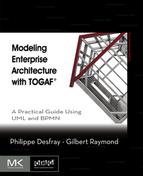Foreword
Enterprise architecture is the principal formal tool available to general managers working on the continuous transformations that are necessary to their business. We live in a world characterized by its complexity—the richness of interactions and the speed of perpetual change. Consequently, the evolution of system architecture has been twofold. First, we switched from information system architecture to enterprise architecture to reflect the complex relationships between the information system and its stakeholders. Second, we abandoned the static vision of architecture, which describes a target by means of a “blueprint” that must be rigorously built for a more dynamic view, focusing on the continuous enrichment of the “situational potential” of the company and its information system. The ongoing transformation is based on a double alignment: that of all stakeholders around common objectives and capabilities and that of the potential of the “system” on the “opportunities” of the business environment, designated as “strategic alignment.”
Enterprise architecture remains a difficult art that requires the support of methods like TOGAF from The Open Group. Enterprise architecture is primarily an act of communication between senior management, business management, and IT specialists. It therefore needs a common language and a consensus on words and their meanings. Enterprise architecture is a collective practice that aims to find compromise between divergent views and that requires each party to cooperate for the common good. For this reason, an external repository is required as an exogenous justification of the steps and the effort required of each participant. According to TOGAF, architecture is not just a matter for IT specialists but rather a subject that concerns all roles within a company. Because this is a complex proposal, it must follow a method, and this is precisely what TOGAF offers and what this book deals with. Enterprise architecture is a difficult subject, and we should use other people’s work and enjoy their “best practices,” which is exactly how TOGAF has been built over the years, from the 1990s onward.
TOGAF is the result of very large-scale group work, and is a “treasure chest” that requires a guide and a manual. The book you have in your hands is the key to this chest, and is designed to enable you to enjoy these treasures without getting lost. TOGAF has been developed openly, and the main TOGAF documents are available online. However, these documents are extremely rich (the result of group work) and somewhat intimidating because of the inevitable complexity of the metamodel that structures the approach. Nonetheless, this architecture approach metamodel is the very cornerstone of enterprise architecture, and this book presents it in a very clear and progressive way. The boxes you will find throughout the book explain concepts and definitions using practical knowledge resulting from the extensive experience of the authors.
System architecture is not learned by reading a book, but rather through hands-on experience. However, the use of a method that follows the approach of the TOGAF framework will enable better capitalization and most importantly easier communication with other architects. It is interesting to understand the genesis of TOGAF: committee work consists of bringing together best practices, and filtering them according to how their relevance is perceived by each member of the work group. This still results in a very rich volume of material, which is not necessarily “coherent” precisely because it is too rich and does not have the consistency of an approach proposed by a small group of people. TOGAF provides a checklist to ensure that the enterprise architecture approach that you are using will not end up in a dead end, a toolkit whose aim is not to implement all best practices but rather to import those that consolidate the weaknesses of your own practices, and a standard. The use of a standard is essential if we are to share, compare, and learn from other companies.
This book will be a tremendous time-saver for those who want to become familiar with TOGAF, by clearly indicating the strengths of the method and by providing the more personal view of the authors as a backdrop, enabling TOGAF to be situated in the context of the main IS architecture trends around business objects, services, and processes. One of the most important points is the compatibility between TOGAF and the iterative process, which produces architecture through successive refinements. Constraints linked to complexity and agility have led to the diversification of development methods, which include more and more “agile methods” based on rapid iterations. This possibility of iteratively declining TOGAF is essential, since enterprise architecture is a “fractal” approach, spanning everything from the overall vision of the company to the “simple” information system component development project. The concept of the “solution concept diagram” proposed by TOGAF, which is very well explained in this book, is an iterative and fractal approach to the design of subsystems, starting with a simple and comprehensive vision that can be shared with future clients and users. This is exactly what could be called “agile architecture.”
